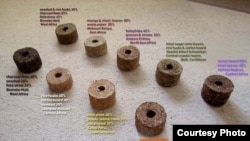This is Part Five of a five-part series on Renewable Energy for Africa
Continue to Parts: 1 / 2 / 3 / 4 / 5
A few years ago, Richard Stanley received an invitation to a government-sponsored energy conference in a plush hotel in Malawi’s capital, Lilongwe. Jaded from attending such seemingly endless “talk shops,” the veteran American aid worker decided to turn things upside down.
Gasps, the uncomfortable shuffling of feet and stunned stares from suit-wearing state officials followed Richard’s entrance into the conference hall. With him was a posse of barefooted women, holes in their clothes and babies on their backs, who he’d driven to Lilongwe from a village on the outskirts of the city.
Richard recalled, “They sat on the floor of this posh hotel because they refused to sit on the chairs. On the floor in front of them they spread their bags….”
The women’s sacks were filled with “biomass briquettes” that Richard’s Legacy Foundation – an NGO he and his wife, Joyce, founded in 1994 – had taught them to make. Rather than him giving a bland power-point presentation, Richard wanted the villagers to tell Malawi’s government and energy experts with their own voices how these simple but unique objects had revolutionized their lives.
The briquettes are made from wastepaper and plant and agricultural waste that are combustible – including grass, straw, water hyacinths, maize and rice husks, peanut shells and potato and banana peels. Using a press, the shredded waste is pounded into briquettes that look like large doughnuts. They burn far longer and much cleaner than charcoal.
“At the conference, one of these old women strode to the stage and eloquently demanded of the senior government officials present, including Malawi’s vice president, ‘We need you to acknowledge who we are and what we are doing because it is making a big difference in our community.’”
The woman then ordered everyone into the hotel parking lot, where she lit a briquette in a tiny jiko (stove) and brewed a pot of tea within minutes. The state officers were so impressed that they bought the women’s entire stock of the cooking fuel.
“The briquettes were disappearing as fast as the money was vanishing into these women’s skirts!” Richard remembered, laughing.
He added, “Then at the end of the conference, the old woman stood up again and asked the government officials for their conference documents. The organizer stood up and looked at her. He was trying to be condescending when he said to her, ‘I didn’t know you could read; I’m really impressed.’ She replied, ‘No, no. I want the paper for making briquettes. Thank you.’”
The anecdote says a lot about how important the briquettes have become in many communities across Africa, Richard noted.
Mass production ensures profits
In cooperation with international associates, the Foundation supplies metal, hand-operated presses that allow producers to churn out a briquette every 30 seconds. The devices are small and mobile.
“We fell into the notion of ratchet presses because the briquette itself has to be produced at such a rate as to make it profitable,” said Richard. “The cost of the briquette is bound up in the kind of machine that’s used to produce them. It’s almost all labor intensive so the faster you make them, the cheaper they get. Briquettes will generally cost between two and a half and four U.S. [United States] cents apiece.…”
Foundation studies show that a family of six typically uses between 12 and 15 briquettes per day for cooking and heating water with which to wash. This makes them a cheaper source of energy than charcoal.
Joyce said it’s always quite challenging at first to convince people who have always only used wood for cooking and heating that a briquette made from waste is a viable alternative.
“There is some resistance or skepticism…. There’s always a little bit of, ‘Is this really going to work? Isn’t it going to be smoky; is it going to burn as fast and well as wood?’”
But she said people soon realize that the briquettes ignite faster than wood, generate much less smoke, last much longer, and eliminate the need for women and children to journey long distances in search of firewood.
Their use also prevents deforestation, although Joyce said that conserving the environment is not always high on a poor person’s priority list.
“Their foremost concern is to find a better source of fuel for their cooking – either because it is dangerous for them to go into the bush to find wood, or the wood is too far because around their villages it has been depleted, or it is simply too expensive,” she said.
Earning an income also becomes important, as mass production allows briquette makers to sell their products – providing them up to nine US dollars a day. Richard commented, “Now that isn’t a lot of money and no one’s ever going to get rich selling briquettes… but for most of the people we train, it’s substantial. That money can be the difference between sinking into extreme poverty and living a decent life.”
Joyce added that some briquette producers have established businesses that have “spun off” from their briquette making activities – enterprises often started by people trained by the Legacy Foundation to be trainers themselves in briquette production.
“Our trainers have businesses, restaurants; they’re using briquettes to cook chapatis [pancakes] and nyama choma [barbecued meat] and different foods,” she said.
Fingertip PHDs
Joyce emphasized that African women are especially good at making briquettes.
“Very often it’s the quietest individuals in a training group who are the best producers,” she said. “They have a PHD in their fingertips. They have an ability to understand the materials and that’s the most important thing…and the realization of ‘will this make a good briquette or not.’”
They are highly innovative, she said. “The women we work with add recipes, change things. They taught us about using eucalyptus [in briquettes] to keep away mosquitoes, [they] just are always adding new things to the briquettes. That’s made a real, real difference.”
But, with most African societies still overwhelmingly male dominated, Richard said some men “get peeved” when women begin earning more money than they do and are empowered through briquette production.
He recalled one particular man who had complained vigorously during a workshop in a district in Tanzania. “He looked at the briquette and he said, ‘Mukufuna nini? ‘Ma toilet paper hii?’ What are you doing with this? Is this toilet paper?’”
Richard laughed, “This man later warmed up to briquette production – as long as he was involved in making the presses, which is what a lot of the men end up doing.”
He said briquette producers in Africa, women and men, generally demonstrate remarkable ingenuity. “They constantly adapt their briquette making according to the resources they already have,” he said.
As an example, he mentioned some villagers in Mali who are using leaves and bark from the neem tree to make briquettes. Neem is a plant with scientifically acknowledged medicinal properties.
The villagers compress their briquettes with a low pressure press using cold water, ensuring that the neem material is compacted into briquettes at a very low temperature.
Richard explained, “What happens is, because you’ve kept the temperature down, you retain the aromas [of the neem leaves]. Now you have this wonderful smelling aroma [from the burning briquettes]. The neem tree [smells] like Vicks VapoRub…and the aroma comes off, without smoke…This drives away mosquitoes, and your home isn’t filled with polluting carbon smoke and dust from burning charcoal.”
Growth in Africa
The network of briquette producers and trainers now extends to more than 50 countries around the world, with Africa being integral to this growth.
“We now have seen the growth of about 1,000 projects all over the world. We’re connected to…places like Rwanda and the DRC [Democratic Republic of Congo] and even in Somalia,” said Richard. “You can just about go anywhere in Africa and find someone who could train you in briquettes, whether it’s east or west, north or south….”
But the Stanleys don’t want praise for their work in fostering a renewable energy technology in Africa and helping develop many parts of the continent.
They said that while they have indeed helped to change people’s lives for the better, it’s the people they work with, including Africans, who have enriched their lives and made them better people.
Richard said, “Our work is to release the potential that already exists in Africa. We come in as technicians; we’re mechanics of a process. We can supply the pots and pans but someone else has to do the cooking.”
And, with briquette making continuing to explode in Africa, that cooking has become a lot easier to achieve.
Continue to Parts: 1 / 2 / 3 / 4 / 5
A few years ago, Richard Stanley received an invitation to a government-sponsored energy conference in a plush hotel in Malawi’s capital, Lilongwe. Jaded from attending such seemingly endless “talk shops,” the veteran American aid worker decided to turn things upside down.
Gasps, the uncomfortable shuffling of feet and stunned stares from suit-wearing state officials followed Richard’s entrance into the conference hall. With him was a posse of barefooted women, holes in their clothes and babies on their backs, who he’d driven to Lilongwe from a village on the outskirts of the city.
Richard recalled, “They sat on the floor of this posh hotel because they refused to sit on the chairs. On the floor in front of them they spread their bags….”
The women’s sacks were filled with “biomass briquettes” that Richard’s Legacy Foundation – an NGO he and his wife, Joyce, founded in 1994 – had taught them to make. Rather than him giving a bland power-point presentation, Richard wanted the villagers to tell Malawi’s government and energy experts with their own voices how these simple but unique objects had revolutionized their lives.
The briquettes are made from wastepaper and plant and agricultural waste that are combustible – including grass, straw, water hyacinths, maize and rice husks, peanut shells and potato and banana peels. Using a press, the shredded waste is pounded into briquettes that look like large doughnuts. They burn far longer and much cleaner than charcoal.
“At the conference, one of these old women strode to the stage and eloquently demanded of the senior government officials present, including Malawi’s vice president, ‘We need you to acknowledge who we are and what we are doing because it is making a big difference in our community.’”
The woman then ordered everyone into the hotel parking lot, where she lit a briquette in a tiny jiko (stove) and brewed a pot of tea within minutes. The state officers were so impressed that they bought the women’s entire stock of the cooking fuel.
“The briquettes were disappearing as fast as the money was vanishing into these women’s skirts!” Richard remembered, laughing.
He added, “Then at the end of the conference, the old woman stood up again and asked the government officials for their conference documents. The organizer stood up and looked at her. He was trying to be condescending when he said to her, ‘I didn’t know you could read; I’m really impressed.’ She replied, ‘No, no. I want the paper for making briquettes. Thank you.’”
The anecdote says a lot about how important the briquettes have become in many communities across Africa, Richard noted.
Mass production ensures profits
In cooperation with international associates, the Foundation supplies metal, hand-operated presses that allow producers to churn out a briquette every 30 seconds. The devices are small and mobile.
“We fell into the notion of ratchet presses because the briquette itself has to be produced at such a rate as to make it profitable,” said Richard. “The cost of the briquette is bound up in the kind of machine that’s used to produce them. It’s almost all labor intensive so the faster you make them, the cheaper they get. Briquettes will generally cost between two and a half and four U.S. [United States] cents apiece.…”
Foundation studies show that a family of six typically uses between 12 and 15 briquettes per day for cooking and heating water with which to wash. This makes them a cheaper source of energy than charcoal.
Joyce said it’s always quite challenging at first to convince people who have always only used wood for cooking and heating that a briquette made from waste is a viable alternative.
“There is some resistance or skepticism…. There’s always a little bit of, ‘Is this really going to work? Isn’t it going to be smoky; is it going to burn as fast and well as wood?’”
But she said people soon realize that the briquettes ignite faster than wood, generate much less smoke, last much longer, and eliminate the need for women and children to journey long distances in search of firewood.
Their use also prevents deforestation, although Joyce said that conserving the environment is not always high on a poor person’s priority list.
“Their foremost concern is to find a better source of fuel for their cooking – either because it is dangerous for them to go into the bush to find wood, or the wood is too far because around their villages it has been depleted, or it is simply too expensive,” she said.
Earning an income also becomes important, as mass production allows briquette makers to sell their products – providing them up to nine US dollars a day. Richard commented, “Now that isn’t a lot of money and no one’s ever going to get rich selling briquettes… but for most of the people we train, it’s substantial. That money can be the difference between sinking into extreme poverty and living a decent life.”
Joyce added that some briquette producers have established businesses that have “spun off” from their briquette making activities – enterprises often started by people trained by the Legacy Foundation to be trainers themselves in briquette production.
“Our trainers have businesses, restaurants; they’re using briquettes to cook chapatis [pancakes] and nyama choma [barbecued meat] and different foods,” she said.
Fingertip PHDs
Joyce emphasized that African women are especially good at making briquettes.
“Very often it’s the quietest individuals in a training group who are the best producers,” she said. “They have a PHD in their fingertips. They have an ability to understand the materials and that’s the most important thing…and the realization of ‘will this make a good briquette or not.’”
They are highly innovative, she said. “The women we work with add recipes, change things. They taught us about using eucalyptus [in briquettes] to keep away mosquitoes, [they] just are always adding new things to the briquettes. That’s made a real, real difference.”
But, with most African societies still overwhelmingly male dominated, Richard said some men “get peeved” when women begin earning more money than they do and are empowered through briquette production.
He recalled one particular man who had complained vigorously during a workshop in a district in Tanzania. “He looked at the briquette and he said, ‘Mukufuna nini? ‘Ma toilet paper hii?’ What are you doing with this? Is this toilet paper?’”
Richard laughed, “This man later warmed up to briquette production – as long as he was involved in making the presses, which is what a lot of the men end up doing.”
He said briquette producers in Africa, women and men, generally demonstrate remarkable ingenuity. “They constantly adapt their briquette making according to the resources they already have,” he said.
As an example, he mentioned some villagers in Mali who are using leaves and bark from the neem tree to make briquettes. Neem is a plant with scientifically acknowledged medicinal properties.
The villagers compress their briquettes with a low pressure press using cold water, ensuring that the neem material is compacted into briquettes at a very low temperature.
Richard explained, “What happens is, because you’ve kept the temperature down, you retain the aromas [of the neem leaves]. Now you have this wonderful smelling aroma [from the burning briquettes]. The neem tree [smells] like Vicks VapoRub…and the aroma comes off, without smoke…This drives away mosquitoes, and your home isn’t filled with polluting carbon smoke and dust from burning charcoal.”
Growth in Africa
The network of briquette producers and trainers now extends to more than 50 countries around the world, with Africa being integral to this growth.
“We now have seen the growth of about 1,000 projects all over the world. We’re connected to…places like Rwanda and the DRC [Democratic Republic of Congo] and even in Somalia,” said Richard. “You can just about go anywhere in Africa and find someone who could train you in briquettes, whether it’s east or west, north or south….”
But the Stanleys don’t want praise for their work in fostering a renewable energy technology in Africa and helping develop many parts of the continent.
They said that while they have indeed helped to change people’s lives for the better, it’s the people they work with, including Africans, who have enriched their lives and made them better people.
Richard said, “Our work is to release the potential that already exists in Africa. We come in as technicians; we’re mechanics of a process. We can supply the pots and pans but someone else has to do the cooking.”
And, with briquette making continuing to explode in Africa, that cooking has become a lot easier to achieve.








![Using the briquettes instead of wood prevents deforestation – the effects of which are clearly visible in this photograph showing a hillside in Tanzania that’s been stripped almost bare of trees by wood collectors [Photo: Peter Stanley]](https://gdb.voanews.com/29763441-2E7A-4DF2-9979-4709CD6B6A07_w250_r1_s.jpg)





